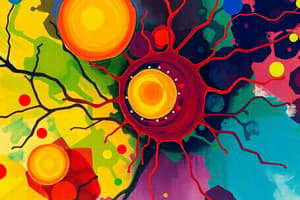Podcast
Questions and Answers
What percentage of the total lymphocyte population do B cells represent?
What percentage of the total lymphocyte population do B cells represent?
- 20-25%
- 10-15% (correct)
- 30-35%
- 5-10%
Which marker is NOT typically associated with B cells?
Which marker is NOT typically associated with B cells?
- CD3 (correct)
- CD20
- CD19
- MHC II
What is the primary function of plasma cells?
What is the primary function of plasma cells?
- Secrete antibodies (correct)
- Destroy foreign pathogens
- Process antigens
- Activate T cells
What role do memory B cells play in the immune system?
What role do memory B cells play in the immune system?
What happens to MHC I expression in cells that are infected with viruses?
What happens to MHC I expression in cells that are infected with viruses?
What role do NK cells play in response to cancerous cells?
What role do NK cells play in response to cancerous cells?
In what circumstances is MHC I expression often suppressed?
In what circumstances is MHC I expression often suppressed?
What is one of the vital functions of NK cells?
What is one of the vital functions of NK cells?
What is the primary function of macrophages in various tissues?
What is the primary function of macrophages in various tissues?
Which type of macrophage is specifically found in the liver?
Which type of macrophage is specifically found in the liver?
Which statement accurately reflects the effect of viral infections on MHC I expression?
Which statement accurately reflects the effect of viral infections on MHC I expression?
How do macrophages primarily clear pathogens from tissues?
How do macrophages primarily clear pathogens from tissues?
In addition to clearing debris, what role do macrophages play in the immune response?
In addition to clearing debris, what role do macrophages play in the immune response?
What specialized structure do macrophages use to engulf particles during phagocytosis?
What specialized structure do macrophages use to engulf particles during phagocytosis?
What systemic features are commonly associated with inflammatory responses?
What systemic features are commonly associated with inflammatory responses?
Which symptom is NOT typically associated with the 'flu-like' symptoms due to systemic inflammation?
Which symptom is NOT typically associated with the 'flu-like' symptoms due to systemic inflammation?
What is the role of costimulatory molecules like MHC-II and B7 in the immune system?
What is the role of costimulatory molecules like MHC-II and B7 in the immune system?
Which of the following is a raised inflammatory marker associated with systemic inflammation?
Which of the following is a raised inflammatory marker associated with systemic inflammation?
Which of these symptoms involves muscle and joint discomfort that can result from systemic inflammation?
Which of these symptoms involves muscle and joint discomfort that can result from systemic inflammation?
What is the primary role of antibody molecules in opsonization?
What is the primary role of antibody molecules in opsonization?
Which term is associated with the process of antibodies marking pathogens for engulfment?
Which term is associated with the process of antibodies marking pathogens for engulfment?
Which statement correctly describes opsonization?
Which statement correctly describes opsonization?
What misconception might one have regarding opsonization and phagocytosis?
What misconception might one have regarding opsonization and phagocytosis?
What is NOT a characteristic of opsonization?
What is NOT a characteristic of opsonization?
What structure extends from the plasma membrane of a phagocyte to engulf a microorganism?
What structure extends from the plasma membrane of a phagocyte to engulf a microorganism?
What is the sac formed around a microorganism during ingestion called?
What is the sac formed around a microorganism during ingestion called?
What happens to the pH inside the phagosome during the ingestion process?
What happens to the pH inside the phagosome during the ingestion process?
What role do enzymes play in the phagosome membrane?
What role do enzymes play in the phagosome membrane?
Which of the following best describes the function of phagocytes?
Which of the following best describes the function of phagocytes?
Flashcards
Macrophages
Macrophages
Cells that consume and break down unwanted material, including pathogens, debris, and old cells.
Küpffer cells
Küpffer cells
Specialized macrophages found in the liver, filtering and destroying harmful substances in the blood.
What are systemic features of infection?
What are systemic features of infection?
These are signs of a systemic inflammatory response. They can appear in the early stages of infection and are caused by elevated levels of immune signaling molecules like C-reactive protein and ferritin.
Alveolar macrophages
Alveolar macrophages
Signup and view all the flashcards
What are 'flu-like' symptoms?
What are 'flu-like' symptoms?
Signup and view all the flashcards
Osteoclasts
Osteoclasts
Signup and view all the flashcards
What are "inflammatory markers"?
What are "inflammatory markers"?
Signup and view all the flashcards
Microglial cells
Microglial cells
Signup and view all the flashcards
What are costimulatory molecules?
What are costimulatory molecules?
Signup and view all the flashcards
Give examples of costimulatory molecules.
Give examples of costimulatory molecules.
Signup and view all the flashcards
B cells
B cells
Signup and view all the flashcards
Plasma cells
Plasma cells
Signup and view all the flashcards
Memory B cells
Memory B cells
Signup and view all the flashcards
B cell surface markers
B cell surface markers
Signup and view all the flashcards
Humoral immunity
Humoral immunity
Signup and view all the flashcards
Opsonization
Opsonization
Signup and view all the flashcards
Importance of Opsonization
Importance of Opsonization
Signup and view all the flashcards
Antibodies and Opsonization
Antibodies and Opsonization
Signup and view all the flashcards
Phagocytosis
Phagocytosis
Signup and view all the flashcards
Opsonization vs. Phagocytosis
Opsonization vs. Phagocytosis
Signup and view all the flashcards
Pseudopods
Pseudopods
Signup and view all the flashcards
Phagosome
Phagosome
Signup and view all the flashcards
Acidification of the phagosome
Acidification of the phagosome
Signup and view all the flashcards
Proton pumps
Proton pumps
Signup and view all the flashcards
Why is MHC I expression suppressed in infected cells?
Why is MHC I expression suppressed in infected cells?
Signup and view all the flashcards
What are NK cells?
What are NK cells?
Signup and view all the flashcards
How do NK cells combat viral infections and tumors?
How do NK cells combat viral infections and tumors?
Signup and view all the flashcards
Are NK cells part of the innate or adaptive immune system?
Are NK cells part of the innate or adaptive immune system?
Signup and view all the flashcards
How do NK cells contribute to viral immunity?
How do NK cells contribute to viral immunity?
Signup and view all the flashcards
Study Notes
Innate Immunity Lecture Notes
- Innate immunity is the first line of defense against infections.
- It's very fast, usually established within 4 hours of infection.
- It's less efficient than adaptive immunity.
- Innate immunity is non-specific.
- It includes mechanical barriers (e.g., skin), chemical responses (e.g., stomach acid), cellular defenses (e.g., phagocytes), and inflammation.
- Innate immunity components include phagocytes (e.g., neutrophils, macrophages, dendritic cells) which recognize and eliminate pathogens by phagocytosis.
- Phagocytes identify pathogens by recognizing pathogen-associated molecular patterns (PAMPs) using pathogen recognition receptors (PRRs), such as Toll-like receptors.
- Cells of innate immunity are activated via chemotaxis (chemical attraction) and adherence (attachment) to the pathogen.
- Microbes are coated with opsonins (e.g. complement proteins and antibodies) to promote phagocyte attachment (opsonization).
- Phagocytosis involves ingestion and digestion of microbes.
- Lysosomal enzymes like lysozyme, lipases, and proteases break down microorganisms within phagocytic vesicles.
- An oxidative burst produces toxic oxygen products to further kill microbes.
- Myeloperoxidase converts chloride and hydrogen peroxide into hypochlorous acid, contributing to microbe killing.
- The residual body (indigestible material) is discharged from the phagocyte.
- Natural killer (NK) cells are part of the innate immune system.
- NK cells do not require activation by specific antigens.
- These cells can identify and destroy virus-infected cells or cancerous cells.
- NK cells release toxic granules to induce apoptosis to infected cells.
- The acute inflammatory response is part of innate immunity, localizing and containing the infection.
- Features of the inflammatory response include vasodilation, increased vascular permeability, release of inflammatory mediators (e.g., bradykinins and prostaglandins), and microvascular coagulation.
- Components that activate the response are innate immune cells, complement cascade, and proinflammatory cytokines.
- MHC (Major histocompatibility complex) proteins (i.e., MHC I, and MHC II) are surface proteins displaying fragments of antigens on cells.
- Phagocytes present processed antigens on MHC proteins to activate the adaptive immune system.
- Adaptive immunity has a delayed response, requiring full pathogen recognition.
- Adaptive immunity is more efficient and specific, including B and T lymphocytes and their associated specific antibodies.
- PAMPs and DAMPs (Damage-associated molecular patterns) are used to identify pathogens and cellular damage.
- NLRs (NOD-like receptors) detect PAMPs and DAMPs inside the cell and initiate inflammation.
Cellular Innate Immune Response
- The cellular component involves specialized cells that recognize and eliminate pathogens.
- Phagocytes (e.g., neutrophils, macrophages, dendritic cells) are crucial for this. They engulf (phagocytose) pathogens, processing and presenting antigens to stimulate the adaptive immune response.
- Neutrophils are the most abundant type, playing a key role in acute inflammatory responses. Neutrophils, after arriving at the site of infection, efficiently phagocytose foreign material, bacteria, and damaged cells.
- Macrophages reside in tissues, performing the same functions as neutrophils, but they are longer-lived and more efficient at presenting processed antigens, serving as crucial linking points between innate and adaptive immune responses.
- Dendritic cells are also phagocytic cells, but their main role is to migrate to lymph nodes and present antigens to T lymphocytes, initiating adaptive immune responses.
Innate Immune Cells - Different Subtypes and Properties
- Granulocytes (e.g., neutrophils, eosinophils, basophils) are characterized by granules in their cytoplasm.
- Neutrophils – the dominant white blood cells during inflammation have a rapid response.
- Eosinophils are primarily involved in responses to parasitic infections and some allergic reactions.
- Basophils are involved in allergic responses.
Studying That Suits You
Use AI to generate personalized quizzes and flashcards to suit your learning preferences.




